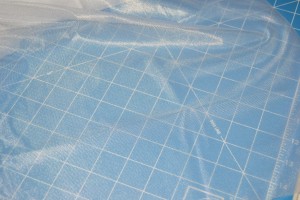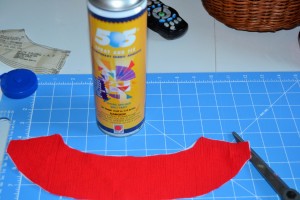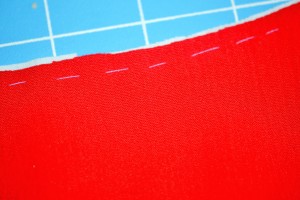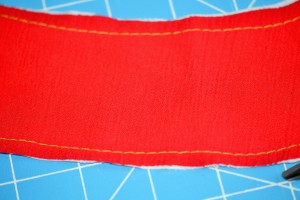We all ooh and aah when someone posts a photo of her fabric stash. What does your interfacing stash look like? Do you use your coupons to buy it by the bolt? Do you just buy what your pattern calls for? Do you skip that step? Do you only use patterns designed by people who never use it?
Come on, now. Oooooh! Aaaaaaah!
If you only make peasant blouses and elastic waist pants, then you probably never need it. But if you have sewn anything that has facings, buttons or snaps, a waistband, or a collar or cuffs, then you’ve used interfacing or should have. There are lots of other places you can improve the look, care, and wear of your garment with some interfacing, but those places need it. A lot of sewists say they don’t like interfacing because it keeps fabric from feeling natural or makes their garments too stiff. While we do use interfacing when we want a crisp look, there are interfacings that are soft and drapey. They support the fabric and give it strength without changing the look and feel of it. Some of them are sheer and can be used with sheer fabrics and lace.
There are two main types of interfacing, fusible and sew in. Today most interfacing is fusible, but there are still times when a sew in is the preferred kind. If your garment is made out of a fabric that cannot stand the iron temperature necessary for fusing, then you need sew in. If your fabric has a texture like seersucker or some of the novelty fabrics, then fusing interfacing to it would alter the character of the fabric so sew in is the right choice. But if your fabric can withstand the fusing process, sheer ease of use says to choose a fusible.
Within both categories of interfacing you’ll find wovens, non-wovens, and knits. With a knit fabric you always want to use a knit interfacing, but you can use all three of them with woven fabrics. The interfacing I use most is a fusible tricot knit. It supports the fabric well, maintains its drape, and provides stability for stitching.
If I want a crisp collar or cuff, it’s not the right choice. Then I’m more likely to choose a fusible woven. I like that I can alter the character of the fabric (or not) by how I cut the woven interfacing. I can cut it on the straight grain of the fabric for maximum crispness, or I can cut it on the bias for a crisp seamline but a softer drape. Non-woven interfacings come in lots of weights, both fusible and sew-in, and they are by far the easiest to find. Since they have no grain, they cut to a very good advantage, and I use them frequently, But they affect the fabric equally in all directions so they don’t offer as much versatility. There are fabrics that are not classified as interfacing that also work well in that capacity. Silk organza, China silk,organdy, tricot knits, muslin, and flannel all have their place as interfacings.
Interfacing can cut down dramatically on wrinkles. If you’re sewing a linen or linen-like garment that will be lined, you should consider interfacing the entire thing. You can pack a linen jacket that’s been totally interfaced in a suitcase, and when you get to your destination, shake it out and wear it nearly wrinkle free. Even unstructured jackets and coats benefit from interfacing in the hem and at the wrist end of the sleeves. A lot of patterns omit interfacing, but you don’t have to. Don’t assume the designer knows best. Interfacing makes your finished projects look more professional and adds longevity to them by keeping them looking fresh longer.
Working with Sew-In Interfacing
When I’m cutting out my pattern, I always cut the fashion fabric first.
Then I use the fabric pieces, not the pattern pieces to cut out my interfacing. That way if I make some small mistakes in cutting, I’ll make them twice, and the interfacing will match the pattern piece.
The interfacing needs to be basted to the fashion fabric pieces before you sew them. You can hand baste them, machine baste them, or use a temporary spray adhesive. If you choose the spray, be sure to test it on a scrap of fabric to make sure it doesn’t discolor or otherwise harm it.
If you decide to machine baste, use the longest stitch your sewing machine has and loosen the tension so the interfacing doesn’t bunch up. If the interfacing is heavy, trim it away from the seam allowances.
Working with Fusible Interfacing
The best and easiest way to work with fusible interfacing with small pattern pieces like collars or a back facing like this is to fuse the interfacing to your fashion fabric before you cut the pieces out.
There’s no better way to get accuracy in your cutting. If it’s cost effective, you can do the same for larger pieces. Follow the instructions that come with the interfacing to get a good fuse. When you have the interfacing fused and the pattern pieces cut out, you just treat the fabric and interfacing as one piece and go ahead with your sewing.
Specialty Interfacing
Sometimes you want something a stiffer than the usual interfacing like to make a hat brim, butterfly wings, or a stiff stand up collar for historical costumes. Then you want something called buckram. If you buy it in quantity, you want to store in on a roll because creases in it limit its usefulness.
Some interfacing comes pre-cut for a special use. Buying them can save you time. A couple of examples would be waistband interfacing and tricot hem tape. They’re nice to have, but you can make them yourself with the right kind of interfacing, a ruler , and your rotary cutter.
There are some places a pattern might not tell you to add interfacing, but if you do, you’ll extend the life of your garment. One of those places is at the opening you create for a drawstring. Pulling on the drawstring puts a strain on the surrounding fabric. If you cut a small piece of interfacing and fuse it to the wrong side of the fabric before you sew the opening, the interfacing will add strength to the fabric and cut down on the wear and tear. Likewise, if for some reason you don’t want to interface the entire button or buttonhole band, you can fuse small pieces of interfacing behind the spots where the buttons or buttonholes will go. You will be surprised at how much better your sewing machine makes buttonholes when there’s interfacing between the layers of fabric. Snaps also adhere better to fabric that has been interfaced.
I wish I could I could make you a chart that says with this fabric, to make this garment, use this interfacing. But choosing interfacing is a lot like pairing food and wine. There are some choices that just don’t work, and those you avoid – like fusing interfacing to seersucker. But there many good choices depending on what you want the finished hand of the interfaced piece to be, what kind of interfacing you like to work with, and what your budget is. When you want to learn about wine, you buy a few bottles of different varieties, and sample them with different foods. The same thing works for interfacing. Buy some different kinds, cut six inch squares of different fabrics, do some fusing, and see what you like. But do make using interfacing part of your sewing even when the pattern directions don’t call for it. You’ll be pleased with the results.
















Great post. I agree with all of it and I love your recommendation to use interfacing even if the pattern doesn’t call for it. I will be sharing this on my Facebook page. Thanks for a great post!
LikeLike
Share away!
LikeLike
I’m really getting a lot out of your posts – such great information!
LikeLike
I’m glad. Come back often, don’t be afraid to ask me to cover something that interests you.
LikeLike
I wasn’t logged in and lost my previous perfectly spelled and witty, insightful comment. In summary, it said you are great and appreciated, and I’ve used flannel!
LikeLike
I like flannel for interfacing. It’s soft and pliable and can add some definition to your stitches if you’re topstitching or doing decorative stitching. My grandmother never bought interfacing. She always used her fabric scraps. As long as they aren’t a darker color or have a print that shows through, they can be fine for sew in interfacing.
LikeLike
Thanks so much for your posts, Roberta. I have a lot from you and can’t wait to read the next ones.
LikeLike
That should have been: I have learned a lot from you.
LikeLike
Thank you for sharing this. I actually do have an interfacing stash, although it’s focused on basic varieties for knit, woven and bags. I appreciate your points about times you might want to use interfacing even if not called for in the pattern.
LikeLike